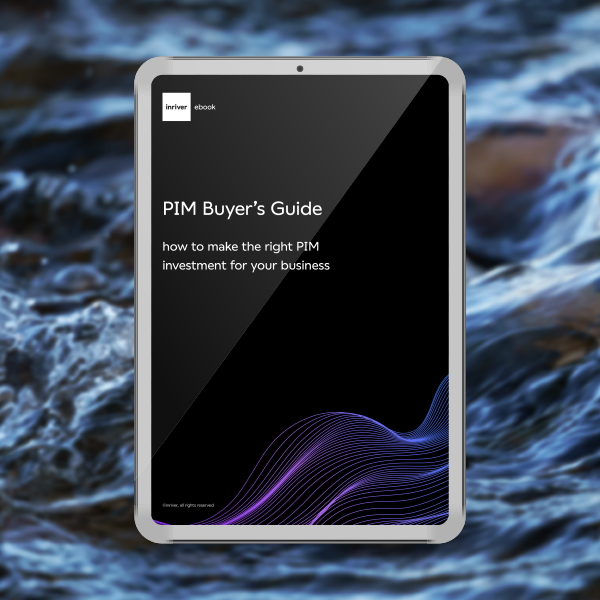What is PIM data?
organize product-related data in one place
Product Information Management software is the foundation of a successful sales and marketing strategy, built on data onboarded from across the value chain.
Behind every product on today’s market lies an elaborate web of data. As a product moves through its circular journey—from manufacturing to marketing, to recycling, and beyond—this crucial data must move with it.
But data fluidity is not enough to win on the digital shelf. This data must transform from raw figures to compelling product details that tell a story, deliver value, and exceed customer expectations. That transformation happens in a PIM.
PIM data, then, is your product data, product taxonomy included, before, during, and after its transformation. This data is the fuel that powers a PIM’s capability to close the loop on a circular product journey.
To meet today’s e-commerce demands, brands, manufacturers, and retailers need to know where the raw data comes from, how to import it into a PIM, and how to facilitate its transformation.
What type of data is stored in a PIM?
In short, any public-facing data related to your products can and should be stored in a PIM. This includes but is not limited to:
- Product descriptions
- Media files
- Pricing
- Discounts
- Dimensions
- Specifications
- SKUs
- Size guides
- Regulatory documentation
A key word here is public-facing data. Private company data usually doesn’t belong in a PIM. It likely belongs in an MDM solution, standing for Master Data Management. Let’s look at the difference between these two similar systems.

What is PIM?
A PIM system, or Product Information Management system, acts as the centralized data hub for brands, manufacturers, and retailers. Its primary role is to onboard, organize, enrich, and distribute product data across digital sales channels, in-store channels, and among internal stakeholders.
What is MDM?
The software known as MDM, or Master Data Management, can be thought of as PIM’s internal counterpart. MDM is the single source of truth for company-related data, like customer data, supplier information, and manufacturer details.
MDM vs PIM
While both MDM and PIM manage data, they do so differently. The difference between PIM and MDM lies in the type of data they handle, and the end user who sees that data.
Where does PIM data come from?
A rich network of product-related data supports products in today’s market. But where does this data come from? In short, data is onboarded from a vast number of sources across the entire product journey. This includes data from material sourcing and manufacturing through to sales, after-sales, and beyond.
Here are the most common sources of PIM data:
Internal data sources
You likely have a wealth of data sitting right beneath your fingertips in your various internal systems. These may include:
- PLM: Product Lifecycle Management holds valuable data about the product lifecycle, from manufacturing details to post-sales support.
- OMS: Order Management Systems provide insights into how products are ordered, tracked, and delivered.
- CRM: Customer Relationship Management tools detail customer preferences, buying habits, and valuable customer feedback.
- DAM: Digital Asset Management platforms house product-related digital assets, like product images, videos, and marketing collateral.
- Excel spreadsheets: The universal default storage system for vast amounts of product data, especially in organizations that haven’t yet fully adopted specialized software.
- MDM: While Master Data Management typically houses internal company data, it can at times carry important manufacturer details like product specifications.

Supplier data sources
Suppliers hold a vault of critical product information that your customers will likely want to know about. The same is true for regulators. A growing number of legislative initiatives, like the EU’s Digital Product Passport, will enter the regulatory conversation in the coming years.
From raw materials to packaging details, supply chain data is increasingly essential if you want to be able to create the product origins stories that are increasingly influential in buyer decisions and regulatory requirements. Supply data sources include:
- ERP: Enterprise Resource Planning software manages a company’s principal operation data, like accounting, supply chain, or product management.
- SRM: A Supplier Relationship Management tool is just like a CRM, but for supplier information, which may be valuable in understanding products from each supplier.
- SCM: Supply Chain Management systems organize the complex data involved in logistics and manufacturing processes.
- Compliance & risk management: These systems house compliance audits and assessments of each supplier, therefore painting the picture of how your products remain compliant and safe.
- Procurement: Tap into your procurement system to understand purchase orders, invoices, and other related data.
Internal team members
In smaller companies, there may not be a sophisticated tech stack of systems to tap into like the ones listed above. In this case, there may be other databases or sources within the organization from which to extract product data.
Your team may store product data manually on spreadsheets or other internal communication systems. You may also need internal subject matter experts to refine and organize product information management data manually.
Digital shelf sources
With Digital Shelf Analytics (DSA), you can gain valuable insights into your products directly from your digital sales channels. DSA technology tracks how your products are performing online and how buyers behave. This insight can help with digital shelf optimization, letting you and your team refine and perfect your customer experience instantly through enhanced data quality.

What does PIM do with this data?
PIM transforms raw product-related data into complete, compelling, and compliant product information used by both internal and external end users. When using an advanced PIM solution with end-to-end capabilities such as product data syndication (PDS) and digital shelf analytics (DSA), this process occurs through four distinct processes:
Onboard
Onboarding data from suppliers and internal data sources is an essential part of managing your product data. From a centralized platform, you’ll be able to review and access all your data from one convenient dashboard, onboard suppliers with an easy one-stop portal, and, when built with a flexible PIM data model, customize how your data functions with no limit on the amount of data you can onboard.
Enrich
This is the crucial transformative step, where raw data turns complete, compelling, and compliant product information that adds value to the end user, whether customer, buyer, or regulator. With an advanced PIM solution, you’ll be able to collaborate cross-company to add compelling details like images, videos, marketing collateral, product guides, and more. Some advanced PIM solutions also offer AI-powered product content creation for every market, taking your product experience management (PXM) to the next level.
Distribute
Some advanced PIM solutions come with built-in syndication capabilities. This means you can funnel your enriched product information across your digital sales distribution channels instantly, accelerating your time-to-market and maximizing profitability at every touchpoint, whether an owned channel or a third-party reseller.
Optimize
Once you’ve syndicated your product information across your digital touchpoints, it’s important to understand how it performs. Advanced PIM solutions have digital shelf analytics (DSA) technology built-in to provide key insight into product performance online. Category-level data allows you to tap into competitor, vertical, and individual product performance to refine your strategy—and supporting data—accordingly.

The data-led benefits of PIM
Having this enriched and transformed PIM data at your fingertips makes you a powerhouse in your market, allowing you to meet the exceedingly steep expectations of consumers and regulators alike.
Not only can you serve your customers better with more organized and informed product data, but you gain the ease for more operational efficiency. Teams like marketing, sales, product engineering, and even accounting all stand to benefit from all your product data housed in one centralized PIM.
Let’s explore some of these data-led benefits:
- Marketing: It’s a tale as old as time for your marketing team: They know that your products are great, but they don’t have access to the manufacturer, supplier, or cross-departmental information to communicate those great qualities to your customers. With PIM data, they do.
- Sales: With customer-focused product features in one place, your sales team can communicate personalized advantages to each customer they speak with—and send follow-up collateral in minutes, not hours.
- Sustainability: As sustainability requirements steepen and consumers demand more transparency, having enriched data accessible in a PIM is a necessity, not a luxury. Easily collect sustainability data for ESG and other reports and tell your customers about your sustainable promises in a simple, compelling way.
inriver: The complete PIM for data-driven product journeys
The composable, multi-tenant inriver PIM offers the most comprehensive Product Information Management solution on the market. Powered by a fully extensible data model that evolves with your product catalog and the demands placed on it, you can be sure you have a solid foundation for even the most complex omnichannel strategy. With built-in syndication and digital shelf analytics technology, advanced data-sharing, and more, inriver offers the complete solution for every business in every market.
want to see the inriver PIM in action?
Schedule a personalized, guided demo with an inriver expert today to see how the inriver PIM can get more value from your product information.
you may also like…
frequently asked questions
who uses a PIM system?
A PIM system is tailored for anyone selling products online. But its true potential is best realized by brands, manufacturers, and retailers with an omnichannel sales strategy. Any organization that seeks a one-stop shop for all their product info can and should take advantage of a PIM solution.
what is stored in a PIM?
Accurate, updated, consumer-facing product data is stored in a PIM. It also stores relevant supporting details, such as product content, supporting media, and sustainability information. In essence, any information about your products, brand, or company that could compel your customers to convert can and should be stored in a PIM.
